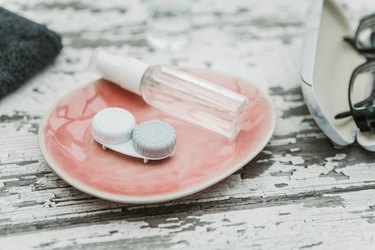
Even if you're diligent about replacing your contact lenses (you really only wear dailies once and truly toss monthlies after 30 days), chances are you're less conscientious about caring for your storage case.
Think about it: When's the last time you swapped your old storage case for a new one? You might not even be able to remember (no judgment).
Video of the Day
Video of the Day
But the American Optometric Association (AOA) recommends you dispose of your contact lens case every one to three months. That's way more often than, say, never.
OK, but is extending your case's expiration date really a big deal?
We spoke to AOA president Robert C. Layman, OD, to understand why overusing your contact lens case can produce problems for your peepers, plus the proper way to clean your case for optimal eye health.
What Happens if You Don't Replace Your Case Often Enough?
When you stretch the shelf life of your contact lens case, you leave your eyes (and vision) vulnerable to potential health issues.
Here's why: Bacteria and biofilm can grow in contact lens cases, Dr. Layman says. Yep, over time, your case can essentially become a petri dish, harboring germs in the threads and around the seals of the case.
And when you don't replace your case in a timely manner, you have a greater chance of developing significant eye infections of the cornea (the clear dome covering the colored part of your eye), Dr. Layman says.
For instance, bacteria and biofilms may increase the risk of both microbial keratitis (infection of the cornea) and infiltrative keratitis (inflammation of the cornea) and even result in sight-threatening vision loss, Dr. Layman says.
What if You Only Wear Contacts Occasionally?
Not an every day contact-wearer? You should still follow the AOA's advice.
The proliferation of pathogens in your contact lens case — and your resultant risk for infection — still stands even if you don't wear your lenses all the time. That's because the longer you use your storage case, the likelier that bad bugs are bound to breed.
How Long Can You Store Contact Lenses in Solution?
While you now know that your contact lens case must be switched out every one to three months, you might also be wondering how often you should replace your solution inside the case, especially if you only wear your lenses infrequently.
All contact lens care solutions are different. “Some solutions are good for one day or 24 hours of storage, while other solutions are good for up to one month in a tightly sealed contact lens case,” Dr. Layman says.
Always follow the manufacturer’s safety instructions for your solution, and if you still have questions, ask your optometrist, Dr. Layman says.
How to Properly Clean Your Contact Lens Case
In addition to replacing your case every one to three months, disinfecting it daily is essential for decreasing the growth of germs and resulting eye infections.
Here Dr. Layman shares step-by-step instructions to clean your case.
- Wash and dry your hands thoroughly before handling your contact lenses.
- Remove your contact lenses from the storage case and empty it of all old solution.
- Rub and rinse the case with fresh disinfecting solution (multipurpose contact lens solution can work as well).
- Wipe the case with a clean, lint-free tissue to remove any excess solution, then allow the lens case to air dry with both the case and caps face down on a clean surface. "This is especially important if cases are stored in humid environments such as a bathroom and can reduce the likelihood of contamination," Dr. Layman says.
- Clean the case after each use.
Never Clean Your Contact Lens Case Like This
Mistake 1: Rinsing With Tap Water
In a pinch, you might have rinsed your contact lens case under the faucet, but tap water can be tainted with microbes.
"Never use tap water to rinse your case as it has been shown to significantly increase the risk of severe ocular infections," Dr. Layman says.
For example, acanthamoeba — a pesky pathogen found in tap water — can cause a rare but serious eye infection that's difficult to treat, according to the Environmental Protection Agency.
Mistake 2: Wiping With Alcohol or Hydrogen Peroxide
Alcohol or hydrogen peroxide that's not specified for ocular use won't be enough to remove a robust biofilm, Dr. Layman says.
Mistake 3: Microwaving or Boiling It
You might think that extreme heat can kill germs and thus effectively disinfect your contact lens case, but it's not a surefire way to sterilize your storage case.
"Microwaving is not a good option since it is impossible to specify the exact microwave type, power and length of treatment," Dr. Layman says.
In other words, unlike an autoclave — a machine operated in medical settings that's calibrated specifically to use superheated steam to destroy microorganisms —you can't be certain that your microwave is banishing bacteria and biofilm.
And the same applies to submerging your case in boiling water, Dr. Layman says.
Is this an emergency? If you are experiencing serious medical symptoms, please see the National Library of Medicine’s list of signs you need emergency medical attention or call 911.